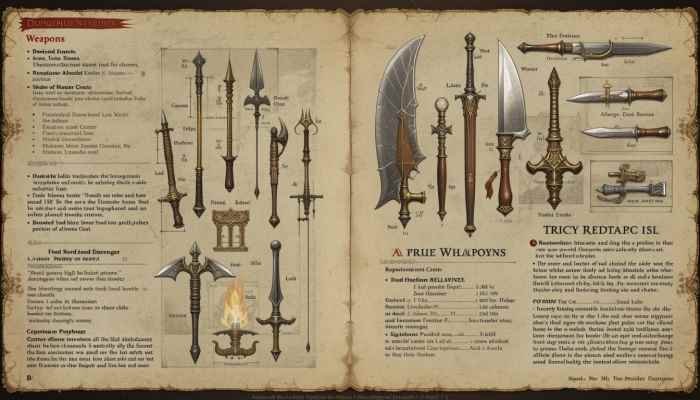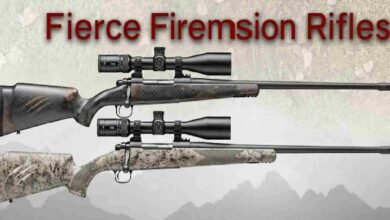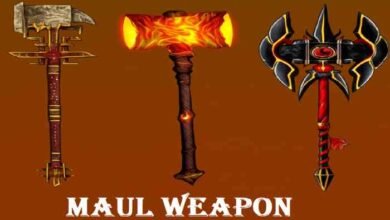Weapons 5e: The Complete Guide to Dungeons & Dragons 5th Edition

In Dungeons & Dragons 5th Edition (5e), Weapons 5e are just pieces of equipment to use in combat, but they are also part of defining your character’s combat style, class abilities, and combat tactics. As a barbarian who likes to rage with a great sword or a rogue who enjoys their finesse weapons, you have choices about how to equip your character that can influence much more than how you attack. As you will see below, your options can affect how you achieve your goals and roleplay your characters.
This ultimate weapon’s 5e guide covers every weapons category in the game: simple, martial, and magic weapons. In addition, we cover how certain classes, like Monks and Druids, interact with unique guns, how silvering or throwing works, and more!
- Understanding Weapon Types in 5e
- Weapon Properties in 5e
- Class-Specific Weapon Interactions
- Improvised Weapons 5e: Creative Combat
- Silvered Weapons 5e: Slaying the Supernatural
- Oversized Weapons 5e: Going Beyond the Norm
- Ranged Weapons 5e: Keeping Enemies at Bay
- Magic Weapons 5e: Power Beyond the Mundane
- Weapon Feats and Mastery
- Weapon Customization and Roleplay
- Sample Loadouts by Class
- Final Thoughts: Mastering Weapons in D&D 5e
Understanding Weapon Types in 5e
Weapons in 5e fall under two main categories:
1. Simple Weapons 5e
These weapons are designed to be easy to use and don’t require special training. Most classes have proficiency with at least some of these weapons.
Simple Melee Weapons 5e
- Club (1d4 bludgeoning)
- Dagger (1d4 piercing, finesse, light, thrown)
- Greatclub (1d8 bludgeoning, two-handed)
- Handaxe (1d6 slashing, light, thrown)
- Javelin (1d6 piercing, thrown)
- Light Hammer (1d4 bludgeoning, light, thrown)
- Mace (1d6 bludgeoning)
- Quarterstaff (1d6/1d8 bludgeoning, versatile)
- Sickle (1d4 slashing, light)
- Spear (1d6/1d8 piercing, thrown, versatile)
These weapons are common and practical, ideal for classes like Clerics, Druids, and Wizards, who typically don’t rely on advanced combat skills.
2. Martial Weapons 5e
Martial weapons require more training and are typically used by Fighters, Paladins, Rangers, and Barbarians.
Examples:
- Longsword (1d8/1d10 slashing, versatile)
- Greatsword (2d6 slashing, heavy, two-handed)
- Battleaxe (1d8/1d10 slashing)
- Warhammer (1d8/1d10 bludgeoning)
- Glaive (1d10 slashing, reach, heavy, two-handed)
- Longbow (1d8 piercing, two-handed, ranged)
Martial weapons 5e often have powerful properties like reach, are heavy, or are versatile, giving more combat flexibility and damage potential.
Weapon Properties in 5e
Each weapon in 5e has one or more properties that affect how it functions in combat. Understanding these traits helps optimize builds and strategies.

Finesse Weapons 5e
These weapons allow the attacker to use Dexterity instead of Strength for attack and damage rolls.
- Dagger
- Rapier
- Shortsword
- Scimitar
- Whip
Ideal for Rogues, Monks, and Dexterity-based Fighters, finesse weapons support agile, hit-and-run tactics and synergize with abilities like Sneak Attack.
Light Weapons 5e
Weapons marked “light” are easier to handle and are typically used for two-weapon fighting.
- Dagger
- Shortsword
- Scimitar
- Handaxe
- Light Hammer
These are excellent for off-hand attacks and can be combined with bonus actions for extra damage each round.
Thrown Weapons 5e
These can be used in melee or thrown for ranged attacks.
- Javelin
- Dagger
- Handaxe
- Spear
- Light Hammer
Thrown weapons, 5e, give melee fighters a ranged option when enemies are out of reach, and they’re particularly effective for Fighters and Barbarians in low-magic campaigns.
Class-Specific Weapon Interactions
Some D&D classes interact with weapons in unique ways, gaining proficiencies, bonuses, or features that change how weapons behave.
Monk Weapons 5e
Monks are martial artists who can use monk weapons—simple melee weapons without heavy or two-handed properties.
Common Monk Weapons:
- Quarterstaff
- Shortsword
- Club
- Dagger
- Spear
Monks can apply their Martial Arts damage dice and Dexterity modifiers to these weapons, enabling fast and efficient flurries of strikes. With Martial Arts and a Flurry of Blows, Monks can attack multiple times using unarmed strikes and monk weapons.
Druid Weapons 5e
Druids restrict themselves from using metal weapons, focusing instead on traditional or wooden tools.
Common Druid Weapons:
- Club
- Dagger (with bone or stone blade)
- Mace (wooden handle)
- Quarterstaff
- Scimitar
- Sickle
- Spear
Druids often enchant their weapons with spells like Shillelagh, making them viable melee combatants using Wisdom as their attack stat.
Improvised Weapons 5e: Creative Combat
Sometimes, a character might use something not designed as a weapon—a chair leg, ale mug, or shovel.
Rules for Improvised Weapons:
- Usually deal 1d4 damage (type depends on object)
- If similar to a real weapon, DM may assign that weapon’s stats
- Not considered proficient unless class features (e.g., Tavern Brawler feat) apply
Improvised weapons 5e add flair to combat and reward creativity, especially in tavern brawls or weaponless scenarios.
Silvered Weapons 5e: Slaying the Supernatural
Many monsters in 5e—like lycanthropes, vampires, and some fiends—are resistant or immune to nonmagical weapons.
Silvering a Weapon:
- Cost: 100 gold pieces per weapon
- Must be done by a skilled smith
- Counts as a mundane workaround for magical resistance
Silvered weapons 5e are a must-have in campaigns heavy with supernatural creatures. Adventurers often carry at least one silvered dagger or sword just in case.
Oversized Weapons 5e: Going Beyond the Norm
Oversized weapons are typically wielded by large or huge creatures (ogres, giants, dragons). For player characters, wielding them is restricted by size and strength rules.

Mechanics:
- Usually not allowed unless DM permits
- Often impose disadvantage due to size
- May be homebrewed to offer extra damage with penalties
The Great Weapon Master feat, Enlarge/Reduce spell, or class features like Rune Knight Giant’s Might allow temporary oversized weapon use under specific conditions.
Ranged Weapons 5e: Keeping Enemies at Bay
Ranged combat allows characters to stay out of melee and pick off enemies from a distance.
Common Ranged Weapons:
- Shortbow
- Longbow
- Crossbows (light, hand, heavy)
- Slings
- Thrown weapons (dagger, spear, javelin)
Ranged Weapon Properties:
- Range is listed in two numbers: normal/maximum (e.g., 80/320)
- Attacks beyond normal range are at disadvantage
- Cannot make ranged attacks in melee unless using feats (Crossbow Expert)
Ranged weapons 5e are essential for classes like Rangers, Fighters, and Rogues that rely on agility or stealth.
Magic Weapons 5e: Power Beyond the Mundane
Magic weapons 5e offer enhanced combat performance and often include special effects or lore. They’re central to mid-to-high level gameplay.

Types of Magic Weapons:
- +1, +2, +3 weapons (bonus to attack and damage)
- Flaming weapons (deal fire damage)
- Vorpal Sword (chance to decapitate on crit)
- Dancing Sword (fights independently)
- Oathbow (targets chosen enemy with bonus damage)
Magic weapons may require attunement and can be aligned with certain classes, patrons, or quests. They are often the goal of legendary campaigns or powerful NPCs.
Weapon Feats and Mastery
D&D 5e includes feats and subclass features that enhance weapon use.
Key Feats:
- Great Weapon Master – Extra attack on kill/crit, +10 damage with -5 to hit
- Polearm Master – Bonus attacks and opportunity attacks with reach weapons
- Sharpshooter – Ignore cover and long-range disadvantage, +10 damage
- Crossbow Expert – No disadvantage in melee, bonus hand crossbow attacks
- Tavern Brawler – Proficiency with improvised weapons and grapple on hit
Weapon Mastery (One D&D Playtest):
New mechanics being introduced allow weapons to apply effects like push, cleave, or topple, adding strategic variety.
Weapon Customization and Roleplay
Weapons are as much about storytelling as mechanics. Players and DMs often personalize weapons with:
- Names (e.g., “Stormpiercer,” “Ashfang”)
- Inscriptions or family crests
- Magical abilities tied to quests
- Sentient weapons with personalities
This kind of narrative flavor transforms basic equipment into treasured heirlooms.
Sample Loadouts by Class
| Class | Weapon Type | Suggested Weapon | Reason |
| Fighter | Martial, heavy | Greatsword or Longsword | Versatile and damage-heavy |
| Rogue | Finesse, light | Rapier and Dagger | Sneak attack with mobility |
| Ranger | Martial, ranged | Longbow | High range and stealth synergy |
| Barbarian | Heavy, two-handed | Greataxe | Synergizes with Rage and Brutal Critical |
| Monk | Simple, finesse | Quarterstaff, Shortsword | Use with Martial Arts and Flurry of Blows |
| Druid | Simple, wooden | Scimitar, Club | Non-metal weapons and spell synergy |
| Paladin | Martial, versatile | Warhammer or Glaive | Can smite with reach or single-handed style |
Also Read: Pathfinder Weapons: A Complete Guide
Final Thoughts: Mastering Weapons in D&D 5e
Weapons in Dungeons & Dragons 5e are more than tools of destruction; they represent your character’s intent, class identity, and creativity. A Monk who wields finesse weapons while performing acrobatic routines, a Druid who relies on equipment borrowed from nature, or the Fighter who uses oversized mauls to crush their enemies with brute force utilize weapons in different ways, but in each case, the gun is a core part of how they play the game.
There are categories of weapons in Dungeons & Dragons 5e, from simple weapons 5e, martial weapons 5e, and even magic or improvised weapons 5e; within those categories of weapons, there is something to represent every moment during a campaign. The dagger is a simple weapon but can represent a sword, silvered blades to use against werewolves, light weapons which can be dual-wielded, and ranged weapons which attack from a distance. Knowing your gear is the first step toward mastering combat in D&D.




